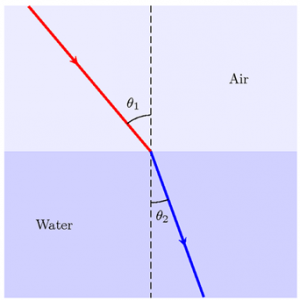Refraction is a bending of the wave when it is entering the medium where the speed is different. The refraction of light when it is passing from the faster medium to a slower medium, bends the light ray towards the normal, to the boundary between these two media. The amount of bending is dependent on the incidence of refraction of two media, and it can be quantitively described by Snell’s law. The images formation by the eyes and lens is also attributed to refraction. The bending of light by the refraction enables us to know rainbows, prisms, lenses, and magnifying glasses. Even the function of the eye is dependent on refraction and without refraction, the light cannot focus on the retina.
Basic Terminologies Associated with Refraction
Normal is the imaginary line that is perpendicular to the interface of media, where there is an occurrence of refraction. The refracted ray is the ray that bends when it is passing from the optical medium to any other medium. The angle between the normal and incident ray is the angle of incidence. Whereas, the distance between the normal and refracted ray is the angle of refraction.
Laws of Refraction
According to the first law of refraction, the incident ray that is refracted ray and it is normal to the interface, they are all lying in the normal plane. Whereas, the second law of refraction shows the ratio between the angle of refraction and the angle of incidence. In the refraction of light, the refractive index is having great importance. If the value of the refractive index of a medium is more, then there is greater bending of light, when the light ray is passing from air to that medium. The material that is having larger values of refractive index is categorized as optically denser mediums. When the light is traveling from more denser mediums to less dense mediums, then it is bending away from normal. But when the light is traveling from less dense medium to denser medium then it is bending towards the normal.

Spectrum can be Created by Refraction
Some experiments were performed by Isaac Newton, by using a triangular block of glass, known as spectrum. He used shining sunlight through his window, for creating the spectrum of colors, on the opposite side of the room. The result of his experiments was that the white-colored light is made up of all colors that are present in the rainbow. Newton proved that these colors cannot be converted to the other colors, but they can be recombined for making the white light.